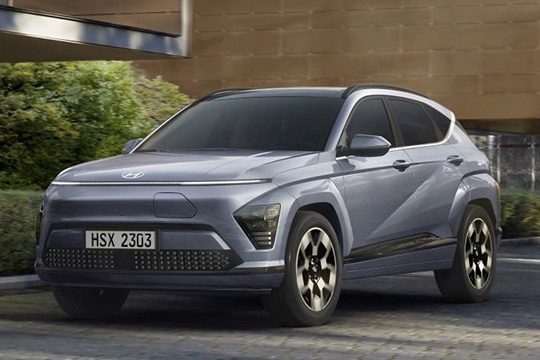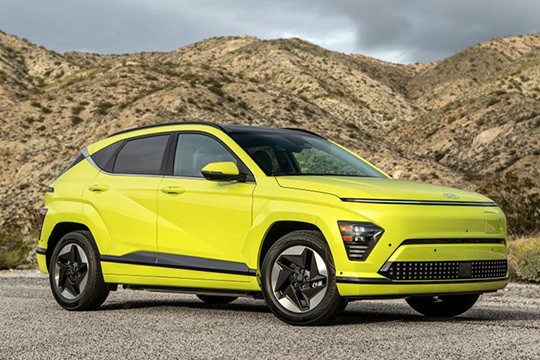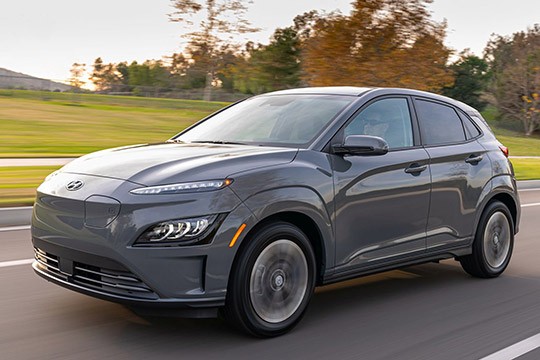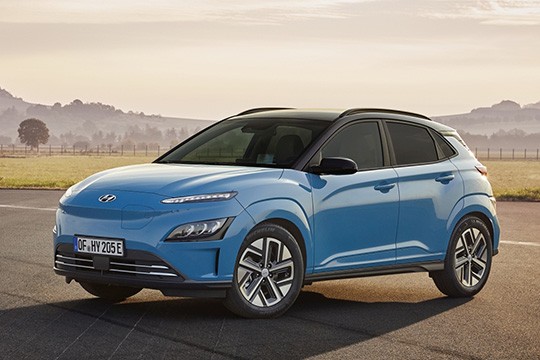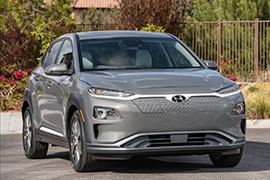HYUNDAI Kona Electric Models/Series Timeline, Specifications & Photos
First production year: 2018
Engines: Electric
Body style: SUV (Sports Utility Vehicle)
Hyundai introduced the second generation of the Kona at the beginning of 2023 for the 2024 model year, which at first, like its predecessor, was only available as an EV.
After testing the market with the first generation of the Kona, followed by the Ioniq5 and Ioniq6, the second generation of its B-segment SUV came as a logical step. But, unlike its predecessor, it put more emphasis on the design language. Thus, the second generation of this vehicle looked like a proper EV, not a converted version of an ICE.
On the front fascia, the design team installed a slim LED strip that crossed the vehicle from side to side above the bumper. In the lower area, on the apron, Hyundai placed a trapezoidal-shaped grille that was tall enough to cool the battery pack and motors, flanked by LED headlights. On the sides, the ascending sculptured line made on the doors, combined with another one that started from the front fenders, created a dynamic look for the SUV. On the N-line trim level, the Kona sported black door mirrors.
Inside, Hyundai placed a 12.3" dual-screen on the dashboard. The one fronting the driver was used for the instrument panel, while the one placed atop the center stack was for the infotainment system. In addition, a 12" projection on the windshield helped the driver navigate without taking their eyes from the road. Its front bucket seats provided little bolstering and were made mostly from recycled materials. In the back, the bench seat could accommodate three passengers on short jaunts or two for long travels.
The automaker offered the Kona with a choice of two motors and two battery packs.
Hyundai revealed the second generation of the Kona Electric for the U.S. market in the spring of 2023 at NYIAS, and even though it was closely related to its European cousin, it was slightly different.
The second iteration of Hyundai's B-segment SUV followed logically after the first generation of the Kona, the Ioniq5, and the Ioniq6 tested the market. But it placed more focus on the design language than its predecessor did. As a result, this 2024 Kona looks like a proper EV rather than a modified ICE-powered vehicle.
On the car's front fascia, Hyundai's design team placed a horizontal LED strip, creating a signature lightning for the Korean brand. It was also present on the 2024 Sonata. There was no grille since there was no need for that, but still, the automaker installed one on the lower part of the bumper to cool the battery pack and flanked it with the headlights. Unlike its European sibling, the U.S. version featured amber blinkers on the corners instead of clear-lense ones. The back of the car looked unusual, with the taillights placed on the outer skirts of the quarter panels.
Hyundai created a modern interior for the Kon, with two 12.3" displays on the dashboard. The one fronting the driver was for the instrument panel, while the one placed atop the center stack was for the infotainment system. In addition, a 12" HUD offered additional information to the driver, so they didn't need to take their eyes off the road. The vehicle provided enough room for five occupants on short jaunts, but on longer trips, the narrow bench seat in the back was not exactly comfortable for three adults.
Hyundai tried to get as many customers as possible, making the 2024 Kona electric available with a choice of two powertrains. The base model featured a lower-powered motor and a smaller battery pack than the top-spec version.
Named after the western district of the Hawaii island, the Kona was a bold step made by Hyundai into the electric car segment with a vehicle that could travel more than the city limits without provoking range anxiety.
Hyundai was true to its words and introduced the Kona lineup in 2017 in three main versions: with internal combustion engines, hybrid-powered, and electric-powered. For that, the Korean carmaker developed an entirely new platform, which was used for the Kia Seltos as well. In late 2020, during the world pandemic, Hyundai confirmed its commitment again and showed the Kona's facelifted version.
From the outside, Hyundai's design team introduced a few modifications to the car's look. The new LED daytime running lights showed an arrow-like design pointed forward. Unfortunately, they kept the charging-port door too visible and looked like it was added at the last moment. But Hyundai tried to convince everyone that it was left like that on purpose, as a clear statement for an electric car. The LED headlights were still lower than the DRLs, and their angular look was aggressive. The compact crossover's overall SUV stance tried to convince the customers to keep coming into Hyundai's showrooms, and it was a successful strategy.
Inside, the carmaker installed a completely digital instrument panel. But the biggest changes were the USB charging ports for the rear passengers. An optional electronic parking brake was available on premium trims as a convenience feature. New ambient lighting illuminated the cup holder and footwells, while an aluminum-like finish added a touch of refinement.
For the 2021 model, Hyundai dropped the lower-powered version and kept the 201 hp electric motor. It was fed by a 64 kWh battery-pack that provided enough energy for up to 132 miles (212 km).
The electric revolution was on, and Hyundai caught a spot on the front row with the Kona Electric in 2018. Just two years later, it decided to refresh the range.
Hyundai claimed that it sold over 120.000 units of the Kona in just two years. After most of its competitors, the small crossover was offered with gasoline, hybrid and electric versions and came late to the party. Maybe a refresh was unnecessary, but the Korean carmaker tried to stay ahead of its pack and introduced a few upgrades on the facelifted version. Thus, it tried to overtake the competition.
At the front, the 2020 Kona electric featured flush to the bumper daytime running lights. Unlike its predecessor, which featured regular round lamps, the new version introduced three curved LED-strips. Designers decided to bring more modifications to the bumper and enhanced it with side-scoops and a lower grille with two horizontal slats. In the middle, they placed the radar for automatic braking and adaptive cruise control. At the back, the taillights were changed with more striking LED lamps and a lower bumper design that mimicked the front one.
Inside, the instrument cluster featured a new 10.25 TFT display with two dials instead of one. To provide an easier reading, it featured white dials instead of black. On top of the center stack, the new infotainment unit with Android Auto and Apple CarPlay connectivity was enhanced and featured lower mounted buttons for easier access.
Hyundai kept the same powertrain options for the 2020 Kona Electric as the non-facelifted version.
Hyundai continued its electrification program and introduced an electric version of its crossover utility vehicle Kona in 2018 at the New York Auto Show.
The Korean automaker was determined to increase its expertise in the electric-car segment. Thus, in 2018, Hyundai unveiled the Kona. While the lineup was available either with an internal combustion engine only or as a hybrid, the electric version came later. But it was an essential step forward in the automaker's electrification strategy.
Since it wasn't designed from the start to be entirely an electric vehicle, the automaker had no other choice than masking the main grille on the front fascia with a decorative panel. It wasn't the most elegant solution, but it worked. Furthermore, to emphasize the car's electric drivetrain, the Kona Electric featured slim LED daytime running lights placed on the upper side of the front fascia. In addition, lower, on the side scoops, the carmaker added the headlights. Last but not least, the air intakes placed lower on the sides of the apron channeled the air around the car to improve aerodynamics.
Inside, the Hyundai designers offered enough room for five passengers and a decent 19.2 cu-ft (544 liters) trunk size. The dashboard was simple and featured the navigation screen (available as an option) on top of the center stack. It wasn't the best place, but it was a good start for the Hyundai's electric evolution.
The drivetrain consisted of a 201 hp electric motor delivered to the front wheels and fed by a 64 kWh battery pack.
